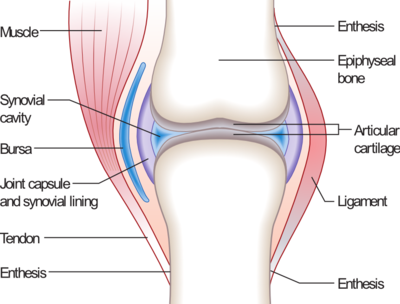Joint

A joint is the location at which two or more bones make contact.[1] They are constructed to allow movement (except for skull bones) and provide mechanical support, and are classified structurally and functionally.[2]
Classification


Joints are mainly classified structurally and functionally. Structural classification is determined by how the bones connect to each other, while functional classification is determined by the degree of movement between the articulating bones. In practice, there is significant overlap between the two types of classifications.
Terms ending in the suffix -sis are singular and refer to just one joint, while -ses is the suffix for pluralization.
Structural classification
Structural classification names and divides joints according to how the bones are connected to each other.[3] There are three structural classifications of joints:
- fibrous joint - joined by dense irregular connective tissue that is rich in collagen fibers [4]
- cartilaginous joint - joined by cartilage
- synovial joint - not directly joined - the bones have a synovial cavity and are united by the dense irregular connective tissue that forms the articular capsule that is normally associated with accessory ligaments.[4]
Functional classification
Joints can also be classified functionally, by the degree of mobility they allow:[5]
- synarthrosis - permits little or no mobility. Most synarthrosis joints are fibrous joints (e.g., skull sutures).
- amphiarthrosis - permits slight mobility. Most amphiarthrosis joints are cartilaginous joints (e.g., vertebrae).
- diarthrosis - permits a variety of movements. All diarthrosis joints are synovial joints (e.g., shoulder, hip, elbow, knee, etc.), and the terms "diarthrosis" and "synovial joint" are considered equivalent by Terminologia Anatomica.[6]
Biomechanical classification
Joints can also be classified based on their anatomy or on their biomechanical properties. According to the anatomic classification, joints are subdivided into simple and compound, depending on the number of bones involved, and into complex and combination joints:[7]
- Simple Joint: 2 articulation surfaces (e.g. shoulder joint, hip joint)
- Compound Joint: 3 or more articulation surfaces (e.g. radiocarpal joint)
- Complex Joint: 2 or more articulation surfaces and an articular disc or meniscus (e.g. knee joint)
Anatomical
The joints may be classified anatomically into the following groups:
- Articulations of hand
- Elbow joints
- Wrist joints
- Axillary articulations
- Sternoclavicular joints
- Vertebral articulations
- Temporomandibular joints
- Sacroiliac joints
- Hip joints
- Knee joints
- Articulations of foot
Joint disorders
A joint disorder is termed an arthropathy, and when involving inflammation of one or more joints the disorder is called an arthritis. Most joint disorders involve arthritis, but joint damage by external physical trauma is typically not termed arthritis.
Arthropathies are called polyarticular when involving many joints and monoarticular when involving only one single joint.
Arthritis is the leading cause of disability in people over the age of 55. There are many different forms of arthritis, each of which has a different cause. The most common form of arthritis, osteoarthritis (also known as degenerative joint disease) occurs following trauma to the joint, following an infection of the joint or simply as a result of aging. Furthermore, there is emerging evidence that abnormal anatomy may contribute to early development of osteoarthritis. Other forms of arthritis are rheumatoid arthritis and psoriatic arthritis, which are autoimmune diseases in which the body is attacking itself. Septic arthritis is caused by joint infection. Gouty arthritis is caused by deposition of uric acid crystals in the joint that results in subsequent inflammation. Additionally, there is a less common form of gout that is caused by the formation of rhomboidal shaped crystals of calcium pyrophosphate. This form of gout is known as pseudogout.
See also
References
- ^ "Joint definition". eMedicine Dictionary. 27 April 2011. Retrieved 27 January 2012.
- ^ Ellis, Harold; Susan Standring; Gray, Henry David (2005). Gray's anatomy: the anatomical basis of clinical practice. St. Louis, Mo: Elsevier Churchill Livingstone. p. 38. ISBN 0-443-07168-3.
{{cite book}}: CS1 maint: multiple names: authors list (link) - ^ "Introduction to Joints (3)". anatomy.med.umich.edu. Retrieved 2008-01-29.
- ^ a b Principles of Anatomy & Physiology, 12th Edition, Tortora & Derrickson, Pub: Wiley & Sons
- ^ "Introduction to Joints (2)". anatomy.med.umich.edu. Retrieved 2008-01-29.
- ^ "synovial joint" at Dorland's Medical Dictionary
- ^ "Introductory Anatomy: Joints". Retrieved 2008-01-29.
